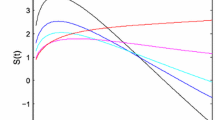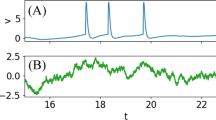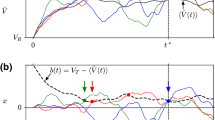Abstract
Providing an analytical treatment to the stochastic feature of neurons’ dynamics is one of the current biggest challenges in mathematical biology. The noisy leaky integrate-and-fire model and its associated Fokker–Planck equation are probably the most popular way to deal with neural variability. Another well-known formalism is the escape-rate model: a model giving the probability that a neuron fires at a certain time knowing the time elapsed since its last action potential. This model leads to a so-called age-structured system, a partial differential equation with non-local boundary condition famous in the field of population dynamics, where the age of a neuron is the amount of time passed by since its previous spike. In this theoretical paper, we investigate the mathematical connection between the two formalisms. We shall derive an integral transform of the solution to the age-structured model into the solution of the Fokker–Planck equation. This integral transform highlights the link between the two stochastic processes. As far as we know, an explicit mathematical correspondence between the two solutions has not been introduced until now.











Similar content being viewed by others
References
Abbott L (1999) Lapique’s introduction of the integrate-and-fire model neuron (1907). Brain Res Bull 50(5):303–304
Abbott LF, van Vreeswijk C (1993) Asynchronous states in networks of pulse-coupled oscillators. Phys Rev E 48:1483–1490
Bressloff Newby JM (2013) Stochastic models of intracellular transport. Rev Mod Phys 85:135
Brunel N (2000) Dynamics of sparsely connected networks of excitatory and inhibitory spiking neurons. J Comput Neurosci 8:183–208
Brunel N, Hakim V (1999) Fast global oscillations in networks of integrate-and-fire neurons with low firing rates. Neural Comput 11:1621–1671
Brunel N, van Rossum M (2007) Lapicque’s 1907 paper: from frogs to integrate-and-fire. Biol Cybern 97:341–349
Burkitt AN (2006) A review of the integrate-and-fire neuron model: I. Homogeneous synaptic input. Biol Cybern 95:1–19
Cáceres MJ, Carrillo JA, Perthame B (2011) Analysis of nonlinear noisy integrate & fire neuron models: blow-up and steady states. J Math Neurosci 1(1):7. 10.1186/2190-8567-1-7
Carrillo JA, d González M, Gualdani MP, Schonbek ME (2013) Classical solutions for a nonlinear Fokker–Planck equation arising in computational neuroscience. Commun PDEs 38:385–409
Cox DR (1962) Renewal theory. Mathuen, London
Dumont G, Henry J (2013a) Population density models of integrate-and-fire neurons with jumps, well-posedness. J Math Biol 67(3):453–481
Dumont G, Henry J (2013b) Synchronization of an excitatory integrate-and-fire neural network. Bull Math Biol 75(4):629–648
Dumont G, Henry J, Tarniceriu CO (2014) Well-posedness of a density model for a population of theta neurons. J Math Neurosci 4(1):2
Dumont G, Henry J, Tarniceriu CO (2016) Theoretical connections between mathematical neuronal models corresponding to different expressions of noise. arXiv:1602.03764v1 [q-bio.NC]
Ermentrout GB, Terman D (2010) Mathematical foundations of neuroscience. Springer, New York
Faisal A, Selen L, Wolpert D (2008) Noise in the nervous system. Nat Rev Neurosci 9(4):292–303
Gardiner CW (1996) Handbook of stochastic method for physics, chemistry and natural sciences. Springer, New York
Gerstner W (1995) Time structure of the activity in neural network models. Phys Rev E 51:738–758
Gerstner W (2000) Population dynamics of spiking neurons: fast transients, asynchronous states, and locking. Neural Comput 12:43–89
Gerstner W, Kistler W (2002) Spiking neuron models. Cambridge University Press, Cambridge
Gerstner W, Naud R (2009) How good are neuron models? Science 326(5951):379–380
Gillespie DT, Seitaridou E (2012) Simple Brownian diffusion: an introduction to the standard theoretical models. Oxford University Press, Oxford
Hodgkin AL, Huxley AF (1952) A quantitative description of membrane current and its application to conduction and excitation in nerve. J Physiol 117(4):500–544
Holcman D, Schuss Z (2014) The narrow escape problem. SIAM Rev 56(2):213–257
Izhikevich EM (2007) Dynamical systems in neuroscience. The MIT Press, Cambridge
Knight B (2000) Dynamics of encoding in neuron populations: some general mathematical features. Neural Comput 12(3):473–518
Knight B, Manin D, Sirovich L (1996) Dynamical models of interacting neuron populations in visual cortex. Robot Cybern 54:4–8
Longtin A (2010) Stochastic dynamical systems. Scholarpedia 5(4):1619
Longtin A (2013) Neuronal noise. Scholarpedia 8(9):1618
Millman D, Mihalas S, Kirkwood A, Niebur E (2010) Self-organized criticality occurs in non-conservative neuronal networks during ‘up’ states. Nat Phys 6:801–805
Newhall KA, Kovačič G, Kramer PR, Cai D (2010a) Cascade-induced synchrony in stochastically driven neuronal networks. Phys Rev E Stat Nonlin Soft Matter Phys 82(4 Pt 1):041903
Newhall KA, Kovacic G, Kramer PR, Zhou D, Rangan AV, Cai D (2010b) Dynamics of current-based, poisson driven, integrate-and-fire neuronal networks. Commun Math Sci 8:541–600
Nykamp DQ, Tranchina D (2000) A population density appraoch that facilitates large-scale modeling of neural networks : analysis and an application to orientation tuning. J Comput Neurosci 8:19–50
Omurtag A, Knight B, Sirovich L (2000) On the simulation of large population of neurons. J Comput 8:51–63
Ostojic S (2011) Interval interspike distributions of spiking neurons driven by fluctuating inputs. J Neurophysiol 106:361–373
Ostojic S, Brunel N, Hakim V (2009) Synchronization properties of networks of electrically coupled neurons in the presence of noise and heterogeneities. J Comput Neurosci 26:369–392
Pakdaman K, Perthame B, Salort D (2009) Dynamics of a structured neuron population. Nonlinearity 23:23–55
Pakdaman K, Perthame B, Salort D (2013) Relaxation and self-sustained oscillations in the time elapsed neuron network model. SIAM J Appl Math 73(3):1260–1279
Plesser HE, Gerstner W (2000) Noise in integrate-and-fire neurons: from stochastic input to escape rates. Neural Comput 12(2):367–384
Schuss Z, Singer A, Holcman D (2007) The narrow escape problem for diffusion in cellular domains. Proc Natl Acad Sci 104(41):16098–16103
Wilbur WJ, Rinzel J (1983) A theoretical basis for large coefficient of variation and bimodality in interspike interval distributions. J Theor Biol 105:345–368
Acknowledgments
We would like to thank both anonymous reviewers whose valuable comments helped us improve our paper. In particular, some important observations over the nature of a possible inverse transform have been made that were included in the last section of the paper.
Author information
Authors and Affiliations
Corresponding author
Rights and permissions
About this article
Cite this article
Dumont, G., Henry, J. & Tarniceriu, C.O. Noisy threshold in neuronal models: connections with the noisy leaky integrate-and-fire model. J. Math. Biol. 73, 1413–1436 (2016). https://doi.org/10.1007/s00285-016-1002-8
Received:
Revised:
Published:
Issue Date:
DOI: https://doi.org/10.1007/s00285-016-1002-8




